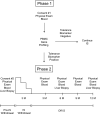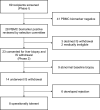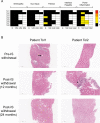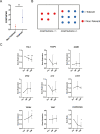Evaluation of a gene expression biomarker to identify operationally tolerant liver transplant recipients: the LITMUS trial
- PMID: 35020854
- PMCID: PMC8802178
- DOI: 10.1093/cei/uxab011
Evaluation of a gene expression biomarker to identify operationally tolerant liver transplant recipients: the LITMUS trial
Abstract
LITMUS was a single-centre, Phase 2a study designed to investigate whether the gene biomarker FGL2/IFNG previously reported for the identification of tolerance in murine models could identify operationally tolerant liver transplant recipients. Multiplex RT-PCR was used to amplify eight immunoregulatory genes in peripheral blood mononuclear cells (PBMC) from 69 adult liver transplant recipients. Patients with PBMC FGL2/IFNG ≥ 1 and a normal liver biopsy underwent immunosuppression (IS) withdrawal. The primary end point was the development of operational tolerance. Secondary end points included correlation of tolerance with allograft gene expression and immune cell markers. Twenty-eight of 69 patients (38%) were positive for the PBMC tolerance biomarker and 23 proceeded to IS withdrawal. Nine of the 23 patients had abnormal baseline liver biopsies and were excluded. Of the 14 patients with normal biopsies, eight (57%) have achieved operational tolerance and are off IS (range 12-57 months). Additional studies revealed that all of the tolerant patients and only one non-tolerant patient had a liver gene ratio of FOXP3/IFNG ≥ 1 prior to IS withdrawal. Increased CD4+ T regulatory T cells were detected both in PBMC and livers of tolerant patients following IS withdrawal. Higher expression of SELE (gene for E-selectin) and lower expression of genes associated with inflammatory responses (GZMB, CIITA, UBD, LSP1, and CXCL9) were observed in the pre-withdrawal liver biopsies of tolerant patients by RNA sequencing. These results suggest that measurement of PBMC FGL2/IFNG may enrich for the identification of operationally tolerant liver transplant patients, especially when combined with intragraft measurement of FOXP3/IFNG. Clinical Trial Registration: ClinicalTrials.gov (LITMUS: NCT02541916).
Keywords: biomarker; gene expression; immunosuppression withdrawal; liver transplantation; tolerance.
© The Author(s) 2021. Published by Oxford University Press on behalf of the British Society for Immunology. All rights reserved. For permissions, please e-mail: journals.permissions@oup.com.
Figures









References
-
- Lechler RI, Sykes M, Thomson AW, Turka LA.. Organ transplantation—how much of the promise has been realized? Nat Med 2005, 11, 605–13. - PubMed
-
- Thomson AW, Vionnet J, Sanchez-Fueyo A.. Understanding, predicting and achieving liver transplant tolerance: from bench to bedside. Nat Rev Gastroenterol Hepatol 2020, 17, 719–39. - PubMed
-
- Devlin J, Doherty D, Thomson L, et al. . Defining the outcome of immunosuppression withdrawal after liver transplantation. Hepatology 1998, 27, 926–33. - PubMed
Publication types
MeSH terms
Substances
Associated data
LinkOut - more resources
Full Text Sources
Medical
Molecular Biology Databases
Research Materials
Miscellaneous

